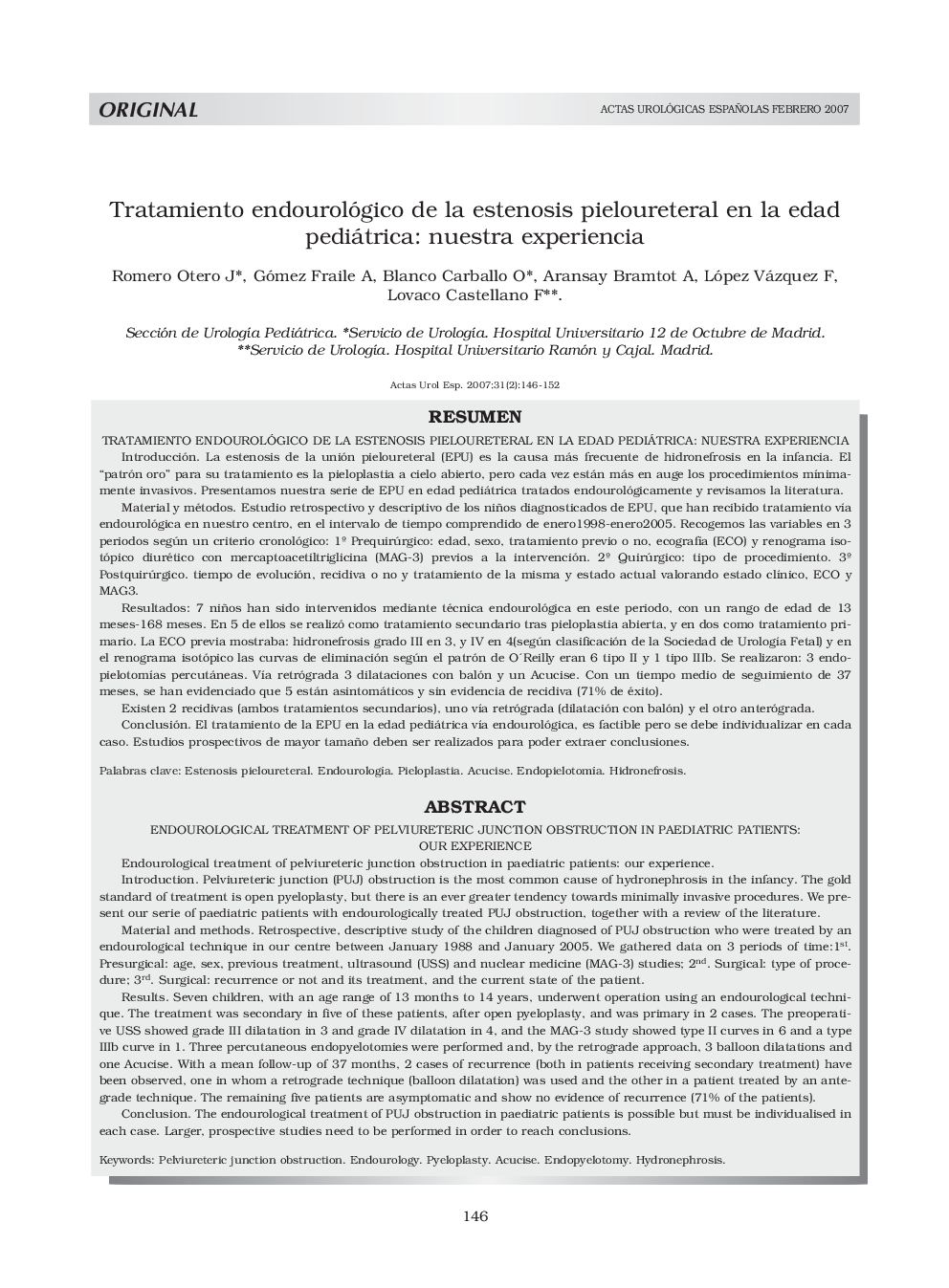| کد مقاله | کد نشریه | سال انتشار | مقاله انگلیسی | نسخه تمام متن |
|---|---|---|---|---|
| 3844920 | 1248176 | 2007 | 7 صفحه PDF | دانلود رایگان |

ResumenIntroducciónLa estenosis de la unión pieloureteral (EPU) es la causa más frecuente de hidronefrosis en la infancia. El “patrón oro” para su tratamiento es la pieloplastia a cielo abierto, pero cada vez están más en auge los procedimientos mÃnimamente invasivos. Presentamos nuestra serie de EPU en edad pediátrica tratados endourológicamente y revisamos la literatura.Material y métodosEstudio retrospectivo y descriptivo de los niños diagnosticados de epu, que han recibido tratamiento vÃa endourológica en nuestro centro, en el intervalo de tiempo comprendido de enero1998-enero2005. recogemos las variables en 3 periodos según un criterio cronológico: 1º prequirúrgico: edad, sexo, tratamiento previo o no, ecografÃa (ECO) y renograma isotópico diurético con mercaptoacetiltriglicina (MAG-3) previos a la intervención. 2º quirúrgico: tipo de procedimiento. 3º postquirúrgico. tiempo de evolución, recidiva o no y tratamiento de la misma y estado actual valorando estado clÃnico, eco y MAG3.Resultados7 niños han sido intervenidos mediante técnica endourológica en este periodo, con un rango de edad de 13 meses-168 meses. En 5 de ellos se realizó como tratamiento secundario tras pieloplastia abierta, y en dos como tratamiento primario. La ECO previa mostraba: hidronefrosis grado III en 3, y IV en 4(según clasificación de la Sociedad de UrologÃa Fetal) y en el renograma isotópico las curvas de eliminación según el patrón de O´Reilly eran 6 tipo II y 1 tipo IIIb. Se realizaron: 3 endopielotomÃas percutáneas. VÃa retrógrada 3 dilataciones con balón y un Acucise. Con un tiempo medio de seguimiento de 37 meses, se han evidenciado que 5 están asintomáticos y sin evidencia de recidiva (71% de éxito). Existen 2 recidivas (ambos tratamientos secundarios), uno vÃa retrógrada (dilatación con balón) y el otro anterógrada.ConclusiónEl tratamiento de la EPU en la edad pediátrica vÃa endourológica, es factible pero se debe individualizar en cada caso. Estudios prospectivos de mayor tamaño deben ser realizados para poder extraer conclusiones.
Endourological treatment of pelviureteric junction obstruction in paediatric patientsour experience. Introduction. Pelviureteric junction (PUJ) obstruction is the most common cause of hydronephrosis in the infancy. The gold standard of treatment is open pyeloplasty, but there is an ever greater tendency towards minimally invasive procedures. We present our serie of paediatric patients with endourologically treated PUJ obstruction, together with a review of the literature.Material and methodsRetrospective, descriptive study of the children diagnosed of PUJ obstruction who were treated by an endourological technique in our centre between January 1988 and January 2005. We gathered data on 3 periods of time:1st. Presurgical: age, sex, previous treatment, ultrasound (USS) and nuclear medicine (MAG-3) studies; 2nd. Surgical: type of procedure; 3rd. Surgical: recurrence or not and its treatment, and the current state of the patient.ResultsSeven children, with an age range of 13 months to 14 years, underwent operation using an endourological technique. The treatment was secondary in five of these patients, after open pyeloplasty, and was primary in 2 cases. The preoperative USS showed grade III dilatation in 3 and grade IV dilatation in 4, and the MAG-3 study showed type II curves in 6 and a type IIIb curve in 1. Three percutaneous endopyelotomies were performed and, by the retrograde approach, 3 balloon dilatations and one Acucise. With a mean follow-up of 37 months, 2 cases of recurrence (both in patients receiving secondary treatment) have been observed, one in whom a retrograde technique (balloon dilatation) was used and the other in a patient treated by an antegrade technique. The remaining five patients are asymptomatic and show no evidence of recurrence (71% of the patients).ConclusionThe endourological treatment of PUJ obstruction in paediatric patients is possible but must be individualised in each case. Larger, prospective studies need to be performed in order to reach conclusions.
Journal: Actas Urológicas Españolas - Volume 31, Issue 2, 2007, Pages 146-152